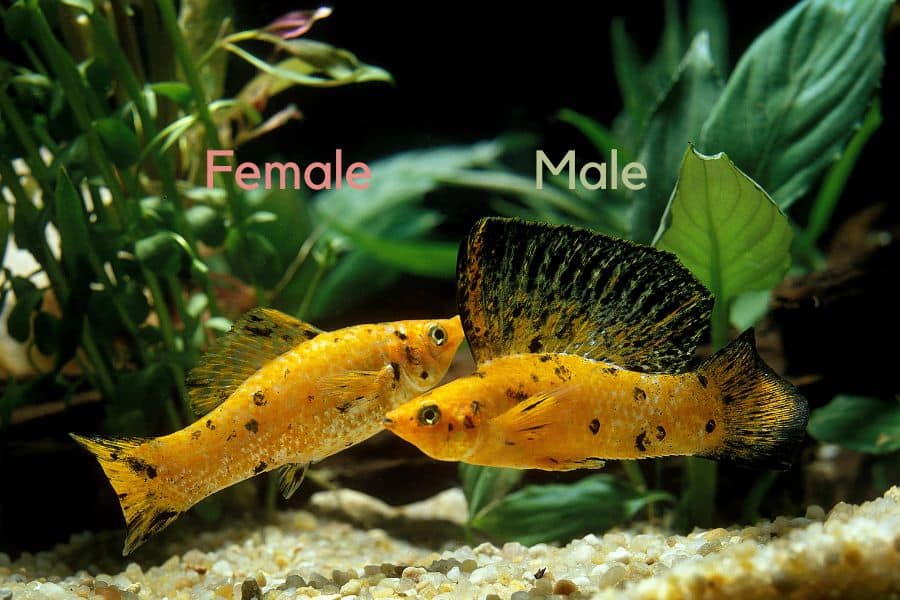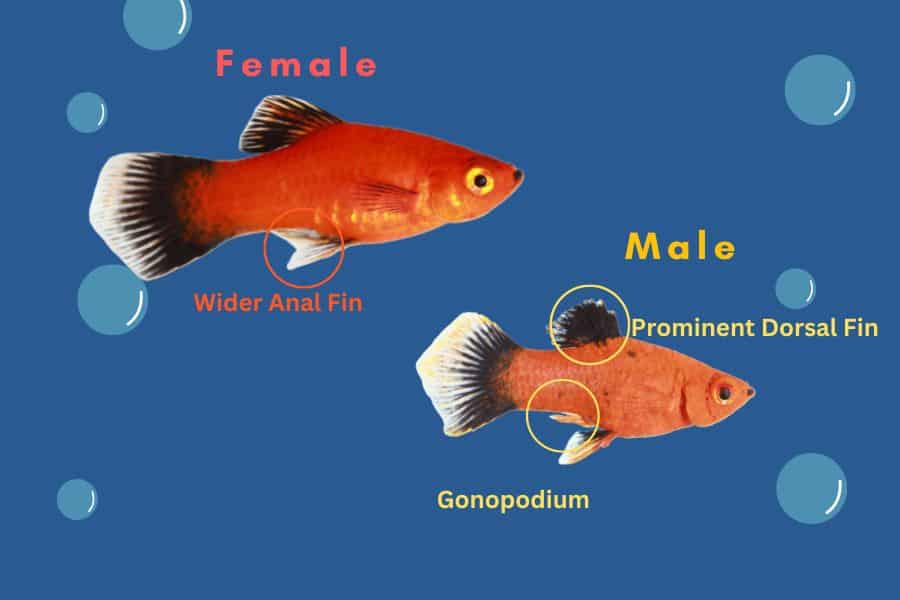Mollies (Poecilia sphenops) are popular tropical aquarium fish that come in several colors, patterns, and sizes. Native to South and Central America, these fish are peaceful and easygoing, making them an ideal choice for novice and experienced aquarists alike.
But before keeping a molly, it’s crucial to learn about its gender. This way, you can understand the fish’s behavior and interactions in the aquarium.
This short comprehensive article offers you an in-depth comparison of male and female mollies based on their physical appearance and behavior.
Overview of Male Vs. Female Molly Fish Difference
Juvenile mollies of each gender often look alike, with enormous eyes and a spindly wriggling tail. They have no notable markings to separate them based on gender. But as they mature (in about eight weeks), it becomes easier to tell them apart.
Male and female mollies vary and have physical and behavioral differences. Males are usually smaller than females and more colorful.
They also have specialized anal fin formatting. Female molly fish are larger and dull with triangular-shaped anal fins and a dark gravid spot that shows readiness to mate.
Physical Differences
1. Body Shape and Size
Male mollies have small and flat bodies, whereas females have large and round bodies. As for size, males can reach a maximum of 2.5 to 3.5 inches, while females can grow up to 5 inches, depending on the species.
However, these values are not constant. Sometimes, male mollies can grow bigger, with bulkier bellies, especially if they have a condition that causes bloating.
Females usually appear larger than males, especially around the abdomen because of their uterus. It pushes the belly, forcing it to assume a round shape.
2. Color
Male molly fish usually come in a variety of vibrant and bold colors, including yellow, silver, gold, orange, and black. Females, on the other hand, have dull and timid color schemes and patterns.
3. Dorsal Fin
The dorsal fin is the fin in the back of the fish. While both males and females have a dorsal fin, the males’ fin is more prominent. The larger the dorsal fin, the more attractive the male molly fish are to females, increasing their chances of mating.
4. Anal Fin
Like in all fish, the anal fin in mollies is located on the underside, just behind the abdomen. This fin offers the most effective way to differentiate between male and female mollies.
In males, the anal fin appears like a tube-shaped fin that never opens wide. Also known as “Gonopodium”, this fin is modified into a copulatory (reproductive) organ used for sperm delivery inside a female molly during breeding. The organ usually shares the dorsal and caudal fins’ color.
Female mollies have a wider anal fin that assumes a triangular shape and moves freely in water when they swim.
5. Gravid Spot
If you still cannot differentiate between male and female mollies using the above physical features, you can look for the gravid spot.
A gravid spot is a dark coloration that appears on the lower side of the female belly when it’s pregnant. It’s a common phenomenon in livebearers and identifies a molly as a female.
The gravid spot usually grows larger and darker towards the end of the pregnancy. Some hobbyists say you can sometimes see the fry’s eyes in the same spot when the female mollies are about to deliver.
Behavioral Differences
Although mollies fish are peaceful, easygoing, and friendly, they can display aggressive and territorial tendencies.
Male mollies can differentiate members of their species and the rest. As a result, they can display aggressiveness towards other male mollies, especially during the mating season.
Since mollies mate every month, males constantly compete to attract the attention of females. That is why you should place enough females in the aquarium. We recommend you keep at least three females for every male molly to minimize mating-related aggressiveness.
Another thing, males often display mating behaviors, like showing off their bright colors and courting females.
Male mollies also fight over food, to establish dominance or protect their territory. To reduce aggressive and territorial behaviors, introduce tank decorations and plants. These will provide enough hiding spots and break the line of sight between bullies and victims.
Unlike male molly fish, females are passive and calmer than males. However, they can become territorial during breeding. Also, the fish may exhibit aggressiveness towards other fish when threatened or there is not enough room in the tank to swim
But most times, female mollies stay in the background and avoid confrontations with tank mates. Besides, they love shoaling with other females and might display courting behaviors towards male mollies.
Also Read:
Molly Fish Care and Maintenance
Diet and Feeding Requirements
Mollies, male and female alike, are omnivores. In captivity, they love a balanced diet comprising animal and plant-based foods. You can also provide them with commercial fish feeds, like flakes, pellets, frozen food, and live foods (such as bloodworms, brine shrimp, and daphnia).
Aquarists encourage molly keepers to feed the fish twice daily in tiny portions that they can eat within two to three minutes. Avoid overfeeding mollies because they can develop health problems. The excess food can also affect the water quality.
Habitat Requirements
Mollies thrive in aquariums that hold at least 20 gallons of water, but large species require a minimum tank size of 30 to 55 gallons. Ensure the tank feature plants, open swimming spaces, and plenty of hiding spot.
Molly fish are hardy species and can tolerate various water conditions. However, they prefer water with higher pH (7.5–8.5) and temperature (72–82°F). But ensure you maintain water quality to prevent a rise in ammonia, nitrite, and nitrate levels in the aquarium.
Health Concerns
Male and female molies can resist a wide range of illnesses but are highly prone to molly disease (shimmies) and constipation.
Shimmies results from poor water quality and extreme temperature changes. The ailment prevents the molly from swimming properly in the tank. They often appear like they wiggle or shimmy in one location.
Constipation in fish often results from overeating. Besides these issues, molly fish can suffer from ich, fin rot, parasites, and bacterial infections. You can avoid all these problems by monitoring water parameters and staying on top of your pet’s eating habits.
Conclusion
Mollies are active, fun, and fascinating aquarium fish. They come in a variety of colors, patterns, and sizes. However, males tend to have more vibrant and bold color schemes than females. They also have a larger dorsal fin that enhances their beauty and attracts females to mate.
Female mollies have bigger bodies and larger anal fins. Also, they develop a gravid spot when pregnant. Naturally, they are peaceful and co-exist with other females, unlike male mollies.
Understanding how to differentiate between male and female molly fish allows you to create a healthy and thriving aquarium environment for your pets. Furthermore, you can provide them with proper care.
We hope you can now tell mollies by their gender. And if you have any queries, inform us in the comment section below.

